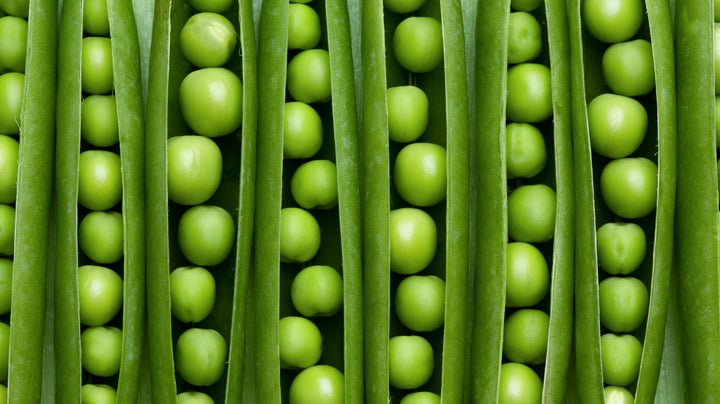
Nicola Williams first noticed there was a problem when her 12-year-old son Henry started vomiting. Before he was two, Henry was diagnosed with multiple food allergies, but his diet had been well managed for almost a decade. Suddenly, something was very wrong.
“I think the first time we realised what it was, he’d had some sausage. Sausages had always been a go to for us,” says the mum from Nottinghamshire. Henry chewed the food and spat it out, but still had an immediate allergic reaction. The otherwise innocent looking pork sausage contained an unexpected ingredient – pea protein.
As the trend for veganism and gluten-free diets grows, food manufacturers have been busy replacing wheat and other ingredients in processed food with a highly concentrated form of dried peas. Healthy, yes, but for some people incredibly dangerous.
Despite their appearance, peas are not a vegetable but a legume, and closely related to the peanut. Like other people with multiple allergies, particularly nut allergies, Henry reacts to many legumes including peas. Yet, peas and pea protein are not recognised by the government as a common allergen. That means food manufacturers and restaurants are under no obligation to alert customers their products may contain peas.
For Williams, feeding her family safely has become even more complicated since the arrival of this new ingredient. “I can’t even buy packed ham now,” she says. “The [cartoon] character ham that kids love? You can’t buy a single one without pea protein now.”
It’s a dilemma also faced by Laurna Hunter from Stirlingshire in Scotland, whose now 14-year-old son has lived with multiple allergies, including peas, since infancy.
“Peas is the trickiest one,” she tells HuffPost UK. “It’s much harder than milk or nuts, especially in the last couple of years. My biggest issue now is how long it takes me to do the shopping because you have to read every single label, and every single thing on the label.”
Hunter made a list of every product she’d stumbled across that contained peas, pea protein or pea fibre. “It’s in cake mix, biscuits, vegan cake, bread, bagels, wraps and rolls. It’s in chips, breaded fish and chicken, sausages, burger, ready meals, ice cream,” she groans. “I don’t know how anybody who would like to be vegan can manage to eat anything that isn’t made from scratch. It’s a huge ingredient in anything plant-based.”
The problem is so widespread that author Alexa Baracaia – who is also juggling family life with multiple allergies – dedicated a chapter to less common allergies in her new book, My Family and Food Allergies: The all you need to know guide.
“The idea of being allergic to something as benign sounding as a pea sounds farcical to many. How can you be allergic to peas? It can’t be serious! In fact, any allergy can be serious,” she says.
“Unfortunately the rise in ‘free from’ and vegan food has been double-edged. Perhaps there’s more choice for those avoiding some of the common allergens, but very often ‘free from’ foods now have pea or lentil flour added into the mix. This is definitely something we are seeing more and more – whether it’s because it adds bulk at an economical price, or ups the protein levels, but these legumes are being put into previously safe products unthinkingly.”

According to research presented at the British Society for Allergy and Clinical Immunology conference in October, pea and legume allergies are the most prevalent of ‘less common’ allergens among children. There are also widespread reports of allergies to peas developing in adulthood.
Pea protein, a powder made from dried green or, more often, yellow peas, is thought to be more dangerous to allergen sufferers than the raw ingredient because it contains a higher concentration of the protein strands that cause an allergic reaction. Now sufferers are calling for peas to be listed as an official allergen to make their lives easier.
Zak Marks, 23 from London, welcomes the call for change. He has been allergic to nuts since childhood but developed an allergy to peas in his mid-teens. He says people don’t take his allergies seriously because of the lack of legislation around legumes. “Often I tell people I’m allergic to peas and they laugh,” Marks explains. “I think people understand more now, but still nothing really happens until someone dies from a reaction, and then a policy is put in place.”
By law, manufacturers must list every allergen on an ingredient list, but ingredients outside the top 14 don’t have to be listed if they make up less than 2% of the product. Sometimes just ‘vegetable fibre’ will be listed, leaving allergy customers no better informed as to whether it poses a risk or not.
And while the Food Standards Agency recommends that packets include a ‘may contain’ warning for any product manufactured using the same equipment as other foods containing common allergens such as peanuts, there’s no requirement to do the same for off-list allergens such as pea protein.
Laurna Hunter has contacted manufacturers asking for information. Most say they are unable to give it. Her son risks anaphylaxis if he consumes even a trace of legumes, so she has stopped buying foods made by companies that use pea fibre in any of their products. Her family’s diet is increasingly restricted.
The lack of awareness is putting lives at risk. Sarah Knight, the founder of The Allergy Team, an online community which supports families living with food allergies, says there is an alarming lack of understanding about pea allergies among the very people responsible for keeping children safe.
She says: “I spoke to a deputy headteacher this year who said, ‘Some of these kids have allergy forms that say they’re allergic to peas; nobody is allergic to peas’. I explained it to her, and she was really mortified by her lack of knowledge. Equally, it was a really clear example of the lack of awareness, and almost that, if you’re not in the top 14, it doesn’t count and people don’t understand.”
Many brands are still marketing their products as allergen free, even though they contain legumes such as peas or lentils. Violife, which sells ‘allergen free’ vegan cheese, recently faced backlash on social media from angry parents of children with multiple allergies when it revealed that some of its products would now contain lentil flour, another product based on legumes.
A spokesperson for Violife said: “To guarantee a good supply of products to our customers across the globe, we need to ensure a steady supply of product, during the last year we have had to change suppliers and with it the change of an ingredient. We are sorry to have caused distress to any customers and can confirm that we have products in development that do not contain lentil protein which we hope our loyal customers will enjoy.”
Other food brands have noticed the big problem that little peas are causing and are being proactive. Heck sausages uses pea protein in its meat and vegan products, and labels it in bold on every ingredients list, even though the company is not required to do so by law.
Andrew Keeble, the founder of Heck, said pea protein was cost effective but he knew it was causing issues for some customers and that the company was moving away from use of peas towards rice. “We believe that it should be an allergen, even though the government say it isn’t. We know that it could kill someone. We wanted to get on the front foot,” he tells HuffPost UK.
However, the charity Anaphylaxis UK is less comfortable with the push for new allergens to be listed, claiming there is “not enough evidence to support extending the list of top 14 allergies to include other legumes” – a position that will disappoint many multiple allergy sufferers.
As for Henry, his mother Nicola Williams hopes that the recent introduction of Natasha’s Law, which requires businesses to provide a full ingredients list for products made and sold on site, will help identify where hidden pea protein could be lurking. “The older he gets, the more aware he is of just checking everything,” she says. “The choice is limited when we carry so many allergies, but I want him to eat out. I want him to be equipped for life in this world. Anything we can do to make it easier to navigate would be amazing.”